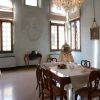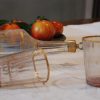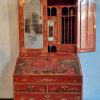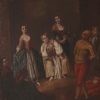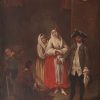Dining room
Avenging wrongs
The scene shown here is inspired by Act Two – Scene 7 and beginning of scene 8
The guests trickle in making a jolly racket about the seating arrangement.
The various courses will be spiced-up by their pranks and jests. Luncheon is over and Lissandro orders the waiters to clear the table and return later to collect the soiled tablecloths. “Putti desparecchiè. Mettè tutto in quella credenza, piatti, possade, biancheria; mettè tutto là che po’ li vegnirè a tor.” (Lads, clear it. Put everything in that dresser, plates, cutlery, linen; put it all there and come back later to collect it).
The scene takes place in a dining room furnished with a table, chairs and a large sideboard with doors that open against the end wall.
We have tried to recreate the atmosphere of the painting “La colazione in villa”(Luncheon at the villa) hanging in the room and shown here on the right, by staging it with an 18th century dining-table, chairs, and wall console from the Veneto area, while the sideboard with chinoiserie decorations is an early 18th century English example.
The Play: The title for the printed edition of this comedy in three acts in the Venetian dialect was presented to the public at the San Luca Theatre on the evening of 5 January 1765 with the suggestive title I chiassetti del carneval (The carnival pranks).
In this choral comedy, each characters has a specific, well defined personality.
According to contemporary accounts, it did not benefit from good acting and this
was the main reason for its failure.
Conversely, since the end of the 19th century it has been reappraised and is now a mainstay for many of the best companies performing in the vernacular in the Veneto.
The Plot: Lissandro, a fake-bauble merchant, wishes to trick the stingy marriage-broker Gasparo, by making him foot the bill for a luncheon and allowing Zanetto to approach his beloved Cattina, Raimondo’s daughter. To avoid raising suspicions, Zanetto pretends he is married, but he is exposed by Raimondo, who will not only get Lissandro to pay for the luncheon, but will bestow his daughter in marriage to Bortolo, Zanetto’s rival.
In this room there are a wall-console in carved wood lacquered in red with multicolour flowers, finished with gilded threading (Veneto area; 1740 – 1760), and a cabinet dresser with three drawers flaps and two mirror-covered doors. Arched moulding interrupted on its upper part by a vase-shaped intaglio. Lacquered in red with gilded lozenge chinoiserie decorations (English area; 1700 – 1710).
Hanging on the walls there are diverse paintings by Falca Pietro called Longhi (in the manner of), 18th century, part of the series “Pastimes in villas”, describing the life of Venetian nobles at the times of Carlo Goldoni (The Kitchen, Luncheon with Masks, The Music Lesson, The Woman from Friuli, The Doughnut Vendor, The Concert, The Ball). Between the two windows there is also a large screen-printing reproducing the “Portrait of Carlo Goldoni” by Lorenzo Tiepolo and Marco Alvise Pitteri. This portrait is found in the first volume of the Pasquali edition of the Commedie (1761) and is taken from a black-pencil drawing by Lorenzo Tiepolo preserved at the Albertina in Vienna. The drawing is in its turn a copy of a youthful painting by Alessandro Longhi. Probably the painting was not appreciated very much by Goldoni, who denies a resemblance in his letter from Paris dated 3 December 1764 to Francesco Albergati Capacelli.
Downloads
Booklet to visit the Museum
Casa di Carlo Goldoni. La Casa del suo Teatro
![]() – Italiano (PDF 839 Kb) >
– Italiano (PDF 839 Kb) >
– English (PDF 858 Kb) >
– Français (PDF 840 Kb) >
